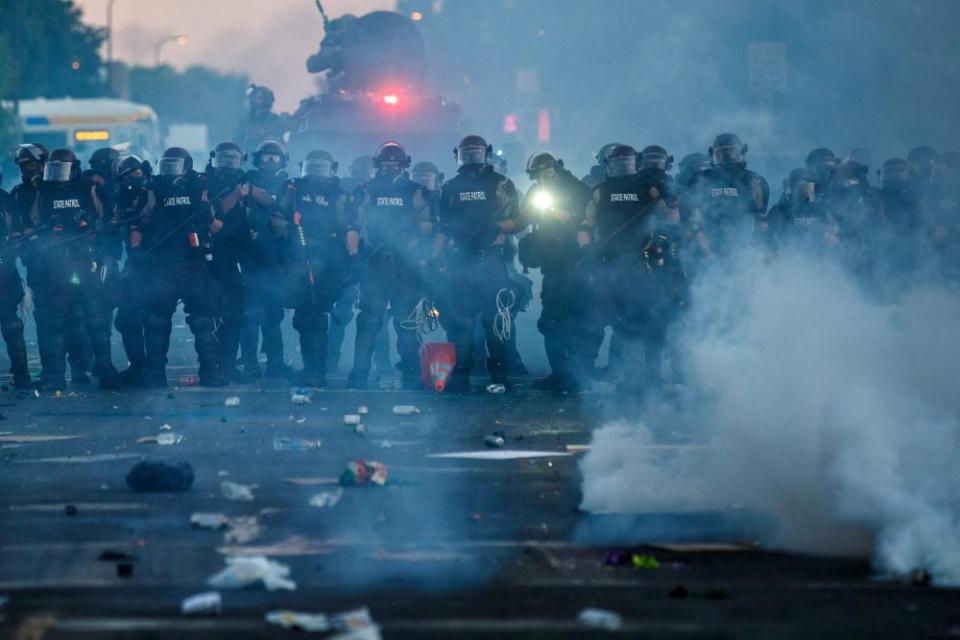Why are some US police forces equipped like military units?
The US is still in the grip of violent confrontations between police and protesters after the killing of George Floyd, a 46-year-old African American man who died in Minneapolis on 25 May after a police officer knelt on his neck for nearly nine minutes.
Thousands of people have been arrested and an untold number have been injured, as police forces stand accused of heavy-handed tactics in their treatment of the public as they demonstrate against the killing.
Despite this, Donald Trump has urged law enforcement officials to “dominate” protesters. Calling for a more forceful approach, he warned that “in Washington we’re going to do something people haven’t seen before.”
Already police officers have used vehicles in New York City to ram into crowds, point canisters and rubber bullets in Minneapolis and teargas in Texas.
But these are just a small taste of the military-grade arsenal that law enforcement officers have at their disposal – with the military handing them hundreds of millions of dollars’ worth of equipment, from mine-resistant vehicles and airplanes, to grenade launchers and rifles.
Since 1997, the US Department of Defense has transferred more than $7.2bn in military equipment to law enforcement agencies.
This is through the 1033 programme, which funnels excess military equipment to police forces for a fraction of the original cost.
Barack Obama restricted the controversial programme in 2015 following criticism that police forces had been too heavy handed in their response to the Ferguson protests, triggered by the killing of Michael Brown.
But Trump signed an executive order reversing the restrictions in 2017. According to the latest Department of Defense figures, police forces across the country now hold about $1.8bn worth of gear.
A 2017 study found that the receipt of military equipment by law enforcement agencies leads to an increase in the number of civilians killed by their officers.
When controlling for other variables, counties with the highest amount of military equipment received were found to record more than twice the number of police killings than those that received no equipment.
“We expect and find that when departments receive more militarized equipment, they behave more violently,” said Ryan Welch, one of the authors of the study.
“Analogous to the ‘law of the instrument’, which states that when you have a hammer, everything looks like a nail, departments with military weapons and gear find more ways to incorporate them in their activities,” he said.
On top of an increased death rate, a 2017 report in the American Economic Journal found that receiving military weapons didn’t help the police in reducing the crime rate.
While transfers of non-lethal equipment such as office and IT supplies were found to lead to a reduction of seven crimes for every 100,000 people, other equipment was less effective.
Vehicles were found to lead to a reduction of 4.7 crimes for every 100,000 while gear such as night-vision goggles led to a reduction of 4.4.
Military weapons did not have an observable effect on the number of crimes.

Despite the questionable benefits of the 1033 programme, data published by the Defense Logistics Agency shows that law enforcement agencies continue to receive thousands of items of military equipment worth millions of dollars.
Mine-resistant vehicles top the list of most expensive items transferred, with police forces operating 1,099 such vehicles originally purchased at a combined cost of $745m (£591m). Some researchers have argued that these heavily armoured vehicles, originally deployed in Iraq and Afghanistan, have no obvious use in domestic law enforcement.
The next most valuable items are utility trucks (2,711 items received worth $184.2m) and planes (13 items worth $98.7m).
As well as tasks such as traffic control and search and rescue, these aeroplanes are used by police to control public order incidents and provide air support to ground operations. Just this week, flight trackers have recorded dozens of police-operated aircraft monitoring protests, including a Predator drone operated by Customs and Border Protection.

The most common items received by the police are magazine cartridges (86,548 items), 5.56mm rifles (54,131) and reflex sights (45,214). These help contribute to the estimated 1 million firearms owned by US law enforcement agencies.


